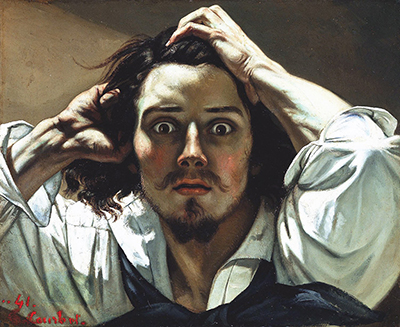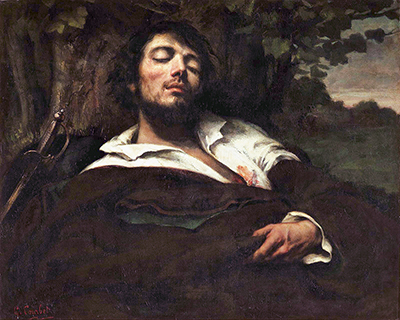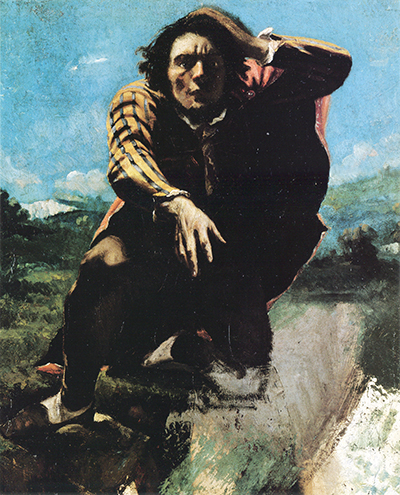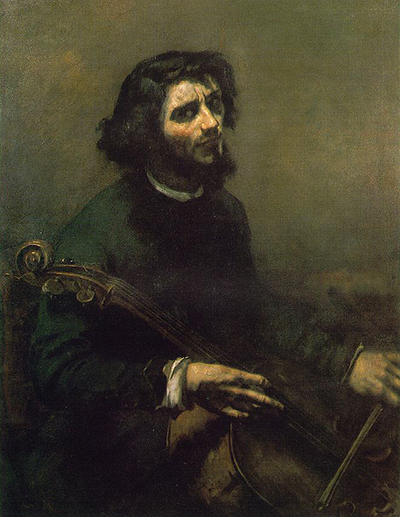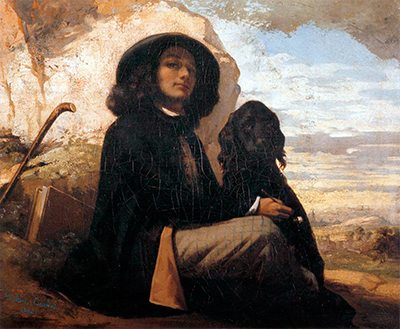This breaktaking self portrait was completed by Gustave Courbet in 1843-1845 and ranks as one of the finest paintings from his entire career. The artist was a charismatic, if sometimes arrogant individual, and this makes his work in self-portraiture all the more intriguing.
Introduction
By the time that he produced this self portrait, it is believed that Gustave Courbet had been rejected several times by the Salon in Paris for other artworks and so the image found in front of us here reflects entirely his frustrations at the time. For someone to have such a strong self-belief and yet still come up short was hard for him to handle. The Desperate Man (Le Désespéré) became a favourite piece for the artist, and he would keep it in his studio for the rest of his life. His oeuvre was deep and varied, but many remember this piece as a highlight because of the impactful nature of the content and also the way in which it allows us to connect directly with the artist's soul. He would have been in his mid-twenties at the time that he produced this painting, and appeared to be impatient in achieving academic respect for his work. Courbet would become regarded as one of the finest French artists of the 19th century and re-visited the sub-genre of self portraiture many more times as his career developed over the next few decades.
The artist would start to achieve success and recognition in the late 1840s, just a few years after this expression of frustration. It was his devotion to the working poor within his paintings that impressed academics, bringing something new to French art. This deeply socialist man would touch on his political leanings during this body of work, but later went down more neutral avenues, such as still lifes and landscapes. He would ultimately take on every major genre at some point in his career and left behind an impressively diverse selection of oil paintings. His expressive nature has made him something of a cult figure and interest in his career has remained fairly constant ever since his death in 1877. He is still highly revered in France, where his legacy is at its strongest. Despite his clear introspection within a series of self-portraits, it is clear that Courbet was not so self-obsessed that he would be unable to look outwards, and did so highly successfully both with portraits of others, but also in how he studied the natural world.
Courbet was someone who became most highly regarded amongst fellow artists, particularly the younger generation of the time. The likes of Monet would collect some of his works for their own interest and Courbet would also take on a number of students himself, several of whom would go on to have successful careers of their own. It is always important to understand the person behind the art and his series of self portraits, as well as a good number of quotes that exist from his life, help us to build up a really strong understanding of his personality and the sorts of factors that motivated him to work in the manner that he did. The Desperate Man (Le Désespéré) is certainly the best of them all in terms of connecting us directly into the soul of this creative and complicated man, and also to understand the difficulties that he experienced as a young artist, prior to achieving the levels of respect and adulation that he craved so deeply. The use of light was also particularly memorable within this piece, as well as the layout of the composition, with Courbet dominating almost the entire canvas.
Table of Contents
- Style
- Description
- Analysis
- Self Portraiture
- Influences
- Size and Medium
- Location
- Exhibitions
- Gustave Courbet's Self Portraits
- Large Image
Style
The lighting and his desperate expression in this portrait are the memorable features of all and this dramatic composition may remind some of the work of Caravaggio and Rembrandt. Courbet was forced into exile many years later and took this painting with him, underlining the fondness that he felt for it. It can now be found in the Conseil Investissement Art BNP Paribas, which is a private collection, but it has been loaned out for public viewing on occasion. Alongside perhaps The Stone Breakers, The Origin of the World, The Painter's Studio and A Burial At Ornans, it is certainly one of his most famous pieces and continues to amaze followers of French art today just as it has done since first being completed all those years ago. The impact of The Desperate Man (Le Désespéré) actually goes beyond Courbet's oeuvre, providing one of the finest examples of self portraiture from the 19th century. It is also regularly covered in art history studies, representing the transition of an artist's inner mood and self reflection onto the canvas itself. Courbet himself would produce a good number of self portraits across his career and clearly favoured this sub-genre.
Description
In this piece the lighting flows in from the left hand side, flooding the artist's face on his right. His long hair hangs loosely and the position of his hands gives an impression of anxiety, perhaps even panic. Notice how his left hand is tightly stretched, with the balance of the light helping to draw out every subtle detail of his body. His eyes are also wide open, bulging, and he looks directly at the viewer, creating a strong connection between us and the artist himself. The plain background tone of brown was chosen to avoid distracting us from his facial expressions, with the flow of light also leading our gaze towards the centre of the painting. His ability to re-produce drapery accurately can be seen here too, with an incredible attention to the various folds and details found in his white shirt. This precision means we can almost feel the material in our hands. In terms of the layout of this composition, Courbet chose to push himself up close in order to create the biggest impact possible. The background only shows through in the top left and top right of the composition, with the rest filled with his animated image.
Analysis
This popular piece has been examined many times by art historians. Different conclusions have been drawn, with some pointing to this being an expression of the artist's personality, whilst others have suggested that actually it was less about mood, but much more about bringing the viewer and the subject closer together. He would, for example, create other self portraits that made use of the same anguish, but with the subject far further back, allowing other elements into the composition. There may be some truth in both views, and we do also know about who the artist had previously studied, and the nature of their own self portraits which is likely to have influenced his own work within this interesting sub-genre. It is also worth placing The Desperate Man (Le Désespéré) within the context of the artist's other self portraits, to see how it compares. Additionally, we do know that he was struggling at the time to achieve academic respect for his work, having been rejected several times by the Salon in Paris, and perhaps this expressive piece merely represented his frustrations at that time.
"...How I was made to suffer despair in my youth!..."
Self Portraiture
No other form of art genre can tell us as much about the artist himself than self-portraiture. Famous artists such as Courbet often have had complex characters and this types of paintings, in addition to any quotes available from their life, is the best way of understanding more about what they did in their careers and why. The comparisons with some of the other artists mentioned here is no coincidence - Courbet studied many painters from the past in the Louvre. At the time it had one of the finest art collections in the world, and that remains very much the case today too. Some artists have even made careers out of just self portraits alone, though this is relatively rare. Rembrandt is an example of someone who found profit to be made from this genre, and so he produced many during his career in order to supplement his own art collection. In other examples it can be seen as a form of therapy, where one introspects and analyses one's mind. Van Gogh self portraits were also common, and his mental instability is well known to the world.
Influences
Courbet is known to have particularly appreciated the work of José de Ribera, Zurbaran, Velazquez and Rembrandt. He would spend time in the Louvre Museum in Paris, studying their work by eye and also sitting further back to sketch various elements of their compositions - whichever technical elements that stood out to him at the time. Some artists have even made a living from producing high quality reproductions of famous paintings during their student years, financing their more creative work that came later. Courbet did not undergo huge amounts of training in his lifetime, not formally at least, and so visits like this were essential to expanding his understanding of the craft of drawing and painting. There are countless more examples of where artists would sit and study within Europe's great museums and galleries before later having their own work featured there themselves, providing something of an organic artistic influence from on generation to the next.
Size and Medium
This self portrait was relatively small, measuring 55cm in width by 45cm in height, or 21 5/8 by 17 3/4 inches. We do know that Courbet kept this artwork within his studio for many years and perhaps would not have been able to had it been much larger. Naturally,The Desperate Man (Le Désespéré) was completed using oil on cavas, which was the standard manner used right across his career and entirely typical of 19th century French art. Courbet was also a highly skilled draughtsman and would likely have completed several sketches of himself prior to commencing this more complex piece in oils. This would have avoided having to make too many alterations at a later stage, which would be harder to implement. We have been unable to locate any watercolour paintings within his oeuvre.
Location
The Desperate Man (Le Désespéré) is now owned by the Conseil Investissement Art BNP Paribas as part of a private collection. As a result, the painting cannot normally be viewed in person but has, on occasion, been loaned out for temporary art exhibitions elsewhere. The organisation is headquartered in Paris, France, and so the painting itself may well be stored within this city most of the time. We have not been able to determine its path of ownership up to this point, as most documentation around the painting remain untranslated from their original French language.
Exhibitions
As mentioned elsewhere, this painting is rarely seen in public but has featured in several exhibitions. An exciting exhibition that was devoted entirely to Gustave Courbet was held at the Musée d’Orsay from October 13th, 2007 to January 28th, 2008. It would later move on to the Metropolitan Museum of Art, New York and the Musée Fabre, Montpellier, running for several months in each location. The Desperate Man (Le Désespéré) was featured within the exhibition and was widely advertised as one of the highlights of this notable event. It was considered the most significant exhibition devoted to the artist for around thirty years and helped to remind younger generations about the importance of his work and the influence that he had on other artists. Burial at Ornans and The Artist’s Studio were also featured as part of a large body of work which numbered 120 paintings and 30 drawings.
Gustave Courbet's Self Portraits
Gustave Courbet once described himself as the proudest and more arrogant man in all France. His self-obsession inevitably led to a number of self-portraits appearing within his career. His body of work in this sub-genre can also be described as varied, in terms of the different styles of compositions. The Desperate Man is memorable because of how close the artist is to the viewer, but in other examples he would be outdoors within landscape settings, perhaps playing a role. His self-portraits tended to involve him looking directly at us, where as his other portraits were something of a mixture. He was regarded as a particularly handsome man which perhaps increased his own ego, as well as making him entirely suitable for modelling for his own work. Besides these artworks, he is also more generally regarded a highly skilled portrait painter. He would take in a great number of genres as he continued to experiment across his career, also becoming respected as a landscape painter as well.
Large Image of Le Désespéré, 1843 (The Desperate Man)
This expressive artwork provides one of the best examples of the use of lighting within European art and many will appreciate the larger image of the painting which is included below, courtesy of Wikipedia. This piece is amongst the finest self portraits, and this larger image allows us to focus on specific elements of the composition, such as Courbet's bulging eyeballs, or the lifelike details found right across his body and folds of clothing. Le Désespéré is an extraordinary artwork which sticks in your memory, and for some it is his finest creation. From what we know about the artist himself, it also helps to communicate to the viewer about his intensive personality, when normally his focus would be directed towards others. The way in which the artist also held such a fondness for this painting also strengthens its authenticity and accuracy in how the artist depicted himself here.
 The Desperate Man in Detail Gustave Coubet.jpg)



